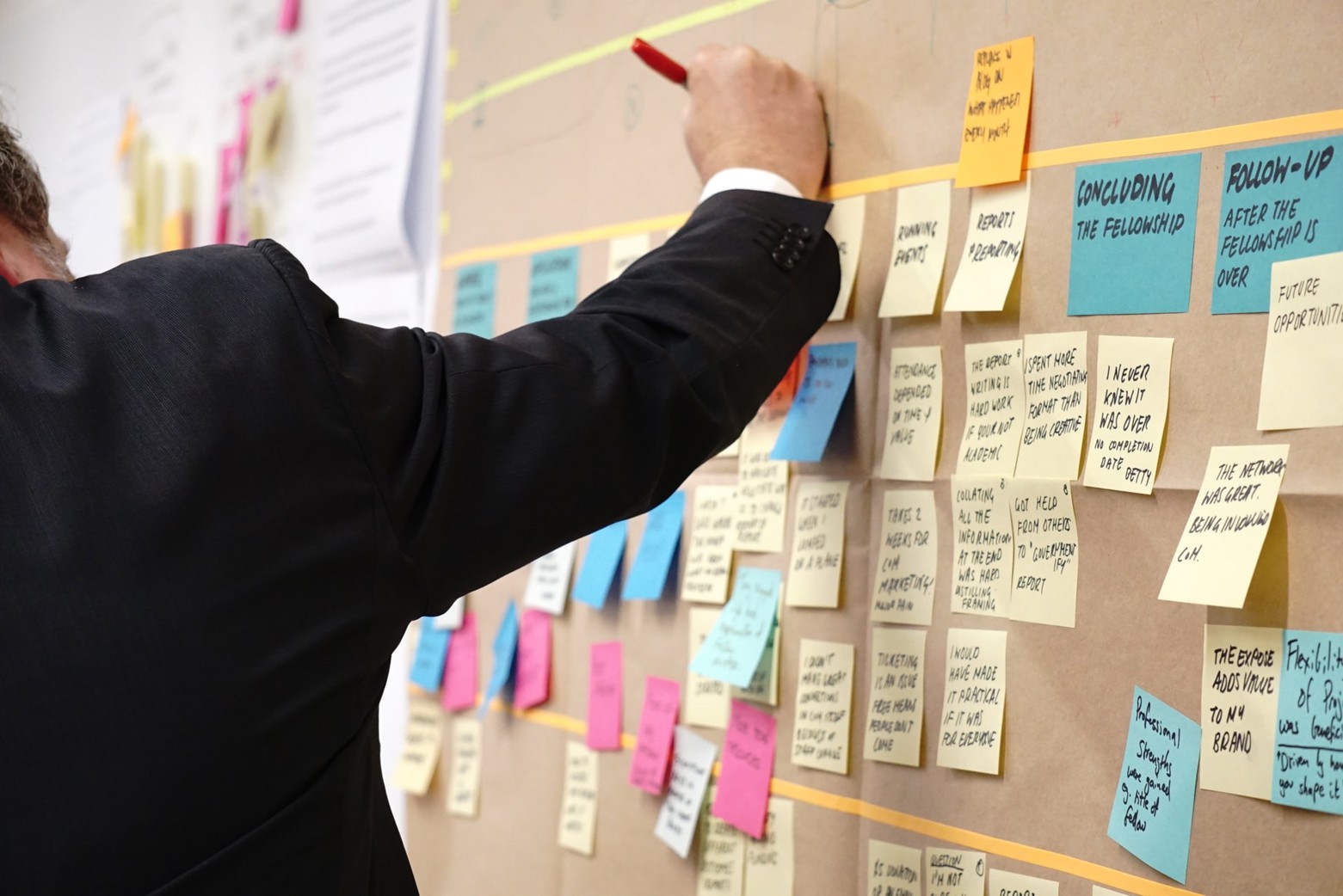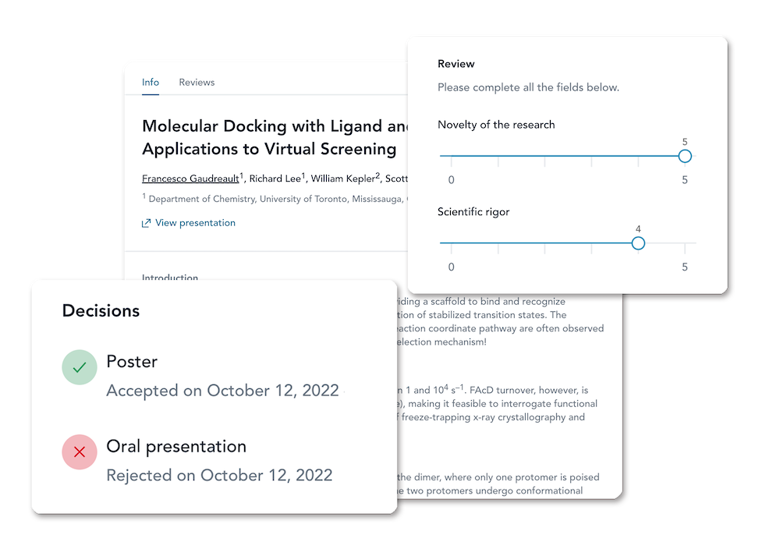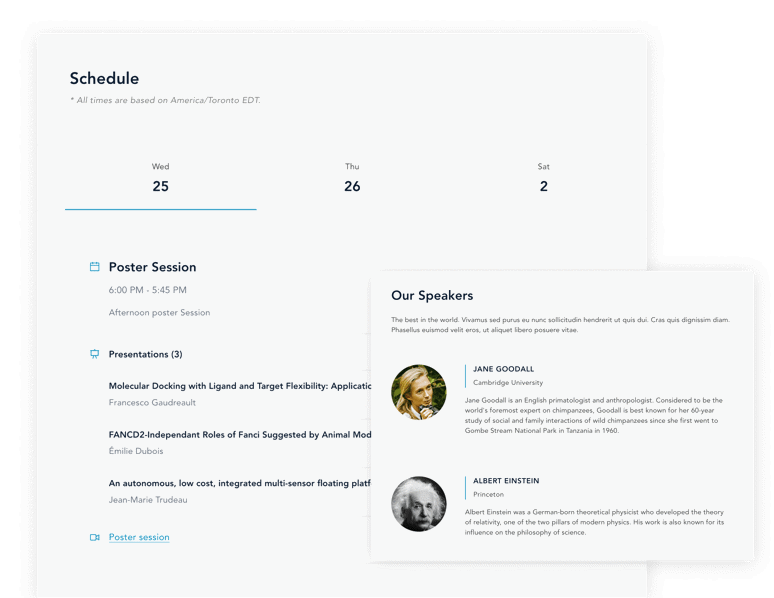How to Create a Conference Program in 8 Easy Steps
A good conference program should be visually pleasing and easy to browse while remaining coherent to the focus of the event. If you’re new to conference organizing, preparing a program can be stressful, but it doesn’t have to be. With proper planning, a bit of research, and the help of readily available tools, building a great conference program becomes easier.
There are three main options to build your event program. You can start from scratch using a program like Word, Google Sheets or Canva, you can use an online tool designed for building programs, or you can use a template like the one you’ll find in this article and simply fill in the blanks with information about your event.
Whether your event is virtual or in-person, this guide provides everything you need to create a great program in a short amount of time that you’ll be able to reuse for annual conferences or seminars.
Organizing a conference?
What is the purpose of a conference program?
A conference program is a visually-pleasing, written agenda defining all of the components of a conference. It is usually presented in table-format, outlining the time and location of your event speakers, welcome reception, breakout sessions, breaks, pre-conference events and social events, all in one easy-to-access document.

To make sure your conference program is easily-digestible by attendees and presenters, it’s important to have the information laid out clearly and concisely, with plenty of space. You don’t want it to look too cramped – if it does, your participants may not bother to read it. Presenting a well designed, easy-to-read program is key.
Different conferences require different program styles. For example, I’ve attended large conferences with complex daily setups. These events had parallel sessions occurring at the same time, and many of the sessions had multiple presenters. In these cases, the conference program is more complex to create. On the other hand, smaller conference programs can basically be a list of who is presenting and at what time.
Conference program vs. conference booklet
Wondering about the difference between conference programs and conference booklets?
A program is the detailed schedule of the event that outlines all of the presentations, breakout sessions and networking breaks. A conference booklet is like a small event guide that contains the program alongside other important information about the event.
What should be included in a conference booklet?
A conference booklet should contain things like: a foreword from the event organizers, a summary of the event and its schedule, a map of the venue (particularly if it’s a large space like a convention center), bios on the keynote speakers, a list of abstracts, information about sponsorships or exhibitors, and a list of event participants.
Conference program template
It can be difficult and overwhelming to build a conference program from scratch, especially if it’s your first time and you don’t have design skills. It can also be overwhelming researching and choosing between the multitude of online tools available to help you create your template.
We’ve created a handy template to take some of the guesswork out of how to format a program and what information to include.
You can download that template in Word or PDF. As we’ve mentioned, every conference has a different structure and different level of information to be shared, so feel free to use this template as-is, or simply as a starting off point to put your own program together.
Be sure to run your template by the Marketing Chair of your event organizing committee, as they’ll likely have a preference around template colors and branding to ensure you’re consistent with the look and feel of other event marketing materials.
In-person, virtual or hybrid
How to Create a Conference Program in 8 Easy Steps
1. Confirm the final list of presenters
Once you’ve run your call for papers and completed your event submission, review and selection process, it’s time to confirm the final list of presenters at your event. You can use a platform like Fourwaves to help you manage and review all submissions, and organize the various presentation types (oral, poster presentation, plenary session, etc.) by acceptance status.

Reach out to presenters to confirm that they’re still interested in participating, and validate any constraints they may face, especially important keynote speakers with busy presentation schedules.
2. Determine the length of the event
This is an important decision that needs to be made before you can start building the conference program. Work with the chairs on your event organizing committee to plan out the length and agenda of the event. Review your presentation submissions and assess how much time is needed to allow for each of these presentations with as little overlap as possible. For a large conference, it’s inevitable that there will be presentations going on simultaneously. Try to avoid scheduling two presentations within the same interest groups at the same time.
Once you’ve determined the presenter list and length of your event (One afternoon? One day? 3 days?) – you can begin to put your program together.
3. Determine the amount of time allocated for each topic
It’s easy to lose sight of the main objective of your event when you’re immersed in all of the details involved in building a conference program. It’s important not to let that happen.
Collaborate closely with your organizing committee to determine which topics or presentations should be considered most important. Then, armed with this knowledge, allocate an appropriate amount of time for each discussion, weighted based on the level of relevance and importance. For example, you could choose to allocate 30% of the event presentation time to the most important topic, 20% to the next most important topic, and so on.
Let’s assume your conference is targeted towards nephrology residents. Determine if you have a target in numbers of CME (continuing medical education) credits. Do you want to allocate a certain percentage of stage-time for early-career investigators to help them kick start their labs? Is there a preferred time ratio allocated between female and male presenters? Is there a set amount of time you want to reserve for presentations given by visible minorities (women, people of color, people who are disabled, etc)?
4. Choose the session types
The main types of sessions are keynotes, tutorials, case studies, oral presentations from students, panel discussions, or plenary sessions, break-out activities, hands-on workshops, field activities, poster sessions, social activities, and networking sessions. Each serves a specific purpose, and there is no easy answer to how many of each session you should include. This decision should be determined by the amount of information that is to be presented within the amount of time available.
5. Create a draft conference program
This is where it starts to get fun.
There are a lot of software programs that can help you get started, but personally I like to start with a spreadsheet tool like Excel, Pages or Google Sheets because they’re simple and familiar, making it very easy to map out a first draft of the event schedule. These tools let you merge and separate cells, calculate time limits, and move things around fairly simply.
The order of the topics presented is up to you. It’s common to see keynote speakers kicking off each session followed by shorter discussions (ie student talks). Remember to allocate time for questions from the audience – this is one of the most valuable aspects of an academic conference for both attendees and presenters – and it’s very important to leave plenty of time for feedback and discussion.
Regardless of whether you’re organizing a live, in-person event or a virtual conference, be sure to leave time for breaks. Not only do these breaks enable conference participants to take care of personal needs like use the washroom, respond to emails, and perhaps indulge in a flaky croissant, they also leave time for networking and making connections –– one of the main reasons academics find these events valuable.
6. Divide and conquer
Remember that you can only be in one place at a time. Once you’ve determined which sessions will be taking place when, appoint a chair for each session. This person will introduce the speakers and manage the Q&A sessions, as well as address any last-minute hiccups that happen in real-time.
7. Create the final version of the program
Once you’ve made all of your important decisions and mapped out your draft conference agenda, it’s time to put the final version together.
There is nothing wrong with using a dressed-up Word or Excel document as your program. You can also save yourself a lot of time and effort by taking all of the information you’ve gathered in the previous 6 steps and incorporating it into the conference program template that is available for download above.
Once you have your final program, upload it to your event website, and, if you plan to provide hard copies to event participants, submit that order to your printer of choice.
You can use a tool like Fourwaves that will link each presentation to the session where it will be discussed, allowing participants to explore the content before the event and prepare themselves with thoughtful, relevant questions and feedback.

8. Share your program
Once you’ve built a conference program that you’re proud of and solicited input from the chairs of your organizing committee, it’s time to share your agenda with your event participants.
Post it to your website and social media pages, be sure that it’s available for participants to view and download well in advance of the event. This is a great piece of content to include in your event communication strategy, as it is an important reason to reach out to attendees and presenters before the event.
Conclusion
Preparing a program is an important step in the planning and organizing of an academic conference. Whether your event is taking place virtually or in-person, Fourwaves can help you save time and simplify processes like soliciting and collecting presentation submissions, managing the review process, organizing sessions, and publishing program content online.
If you’re in the early stages of organizing an academic conference and are looking for help with your conference program or any other element of the planning process, reach out to book a demo with one of our specialists today or try Fourwaves yourself for free.


